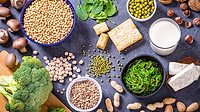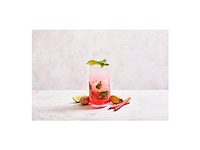Competing for the limelight
Citrus flavors evolve to entice consumers


|
With new beverage flavors fighting for consumers’ attention and juice prices higher than usual due to inclement weather, U.S. orange juice sales have declined during the last several years, says Sarah Theodore, global drinks analyst for Mintel Food & Drink, Chicago. More specifically, orange juice sales were down about 9 percent in food, drug and mass retail, excluding Walmart, between 2008 and 2010, she says.
However, orange is still the preferred juice flavor in the United States — and this year, orange flavors could make a comeback, ingredient suppliers say. According to Mintel, 56 percent of juice drinkers say that orange is their favorite or one of their favorite flavors.
Citrus also continues to appeal in categories outside juice drinks. Globally, 46.7 percent of new citrus-flavored soft drink product launches from July 2010 through June 2011 were orange-flavored, according to Innova Market Insights, Duiven, The Netherlands. And 35.4 percent of fruit-flavored soft drinks launched globally between that same time period were citrus-flavored, it adds. Of the citrus-flavored beverages, lemon took second place globally and in the United States, Innova reports. Lemonade also placed second among juice consumers’ favorite flavors, according to Mintel.
“Nineteen percent of North American juice and juice drink introductions so far this year have included orange as a flavoring component and that’s up from about 13 percent last year,” Theodore says. “Lemonade actually was up a little bit, too. Lemonade accounted for about 4 percent of juice drink introductions so far this year and that’s up from about 3 percent last year. So not a dramatic increase, but it shows that companies are working a lot with lemonade as well.”
Bob Pinkerton, general manager at Rocket Products, Fenton, Mo., also noted this increase. “I believe that consumers are looking for more natural and healthy choices,” he says. “Lemonade and lemonade teas are increasing in sales every year and this started around 2008.”
Citrus choices
Ingredient suppliers also note that citrus varietals and blends have emerged as popular flavor options.
Tropical juices such as mango and pineapple are appearing more often in citrus juice blends, says Matthew Overholser, general manager at Flavors From Florida Inc., Bartow, Fla. He adds that varietals such as Sicilian lemon and Valencia orange are often promoted on packaging.
“Gone are the days of simple profiles,” says Shari Joslin, global category manager of beverages for Firmenich North America, Plainsboro, N.J. “Today’s consumers seek varietals and origin-specific citrus fruits that are either reminiscent of an exotic trip or a fusion dining experience. For example, a Margarita with a touch of Kaffir Lime or a lemonade using Meyer Lemon for complexity and differentiation.”
Formulating beverages with varietal juices or extracts also can increase a beverage’s “good-for-you” value. As these varietal citrus types become more familiar, they will be able to stand on their own, adds Linda Lakind, senior marketing manager of beverages for Firmenich.
While orange- and lemon-flavored beverages are the top two favorites among consumers, according to Mintel, lime is becoming more popular.
“Orange is the most versatile citrus due to its natural sweetness,” says Walter Crawley, director of business development and marketing at Kerry Ingredients & Flavours, Beloit, Wis. “Lemon is popular due to its use in the old classic lemonade. Lime is popular for its unique flavor profile and its ability to blend well with all of the citrus profiles. I have started to see the use of lime with non-citrus flavors at low levels to provide a unique, fresh profile.”
Because people have been consuming citrus for centuries, it is vital that manufacturers maintain its authentic tasting profiles, Crawley adds. And doing so isn’t always easy.
“Juices are used in beverage development to meet consumer needs for healthier, natural or higher premium products,” Firmenich’s Joslin says. “However, juice alone does not guarantee the best tasting beverage. Citrus flavors or essences added to juice-containing products often provide an improved flavor profile.”
Elaine Kellman-Grosinger, director of research and development at Citromax Flavors, Carlstadt, N.J., notes that lemon juice by itself is not enough to impart a full lemon flavor on the beverage. “You need some lemon oil or some lemon flavor because that’s where more of the lemon flavor impact is from,” she says.
These “addbacks” in citrus juices give the product a flavor boost while still maintaining 100 percent juice. “It’s pure, it’s all juice, but [the] flavor gives you the impact and the character, the identity,” she says.
Citrus flavorings also are beneficial in clear beverage applications, such as flavored water, sports drinks or seltzers, because they maintain a clear appearance. On the other hand, using juice in beverages can present a cloudy appearance, thus showcasing the beverage’s juice content, Kellman-Grosinger says. Plus, lemon has the unique ability to provide a natural alternative to citric acid content, she adds.
“Citrus juices help provide nutrition, mouthfeel and appearance to a finished beverage,” says Janet Guzman, vice president of sales and marketing for Flavor Producers, Cincinnati, “whereas a citrus flavor will provide the taste without the appearance and high usage level.”
Formulating with flavors
For some beverage manufacturers, however, flavors have more of an appeal than citrus juices.
“Stability, flavor impact, supply assurance and cost are the main reasons to utilize citrus flavors in beverages,” says Kim Carson, product manager of beverages for North America for Givaudan, Dübendorf, Switzerland. “Often citrus flavors can be designed to provide characteristics of juice, including sweetness, juiciness, richness and aroma. Finally, the use of citrus flavors provides supply assurance and a more economical solution. The reason for this is that less juice is required in flavor development, yet the flavor can be designed to deliver a great-tasting citrus profile in the beverage.”
The ability to replace or reduce juice content with citrus flavorings is becoming increasingly important as citrus prices continue to rise. There’s nothing that can be done about a 100 percent juice beverage, Citromax Flavors’ Kellman-Grosinger says, but companies are trying to cut the juice down when possible. “Say it’s a 10 percent juice, they’ll try to use less of the expensive citrus ones and try to do more blends,” she says. But overall, citrus is just too popular to be affected by pricing, she adds.
Some formulators have mitigated the negative cost impact by using alternate citrus juices, such as tangerine, which can provide a similar taste profile, Flavors From Florida’s Overholser says.
“There has been some negative impact with those companies using lemon and orange [juice], but the demand is still there,” Rocket Products’ Pinkerton says.
Because demand is still prevalent, there likely will not be drastic changes in the formulation of citrus-based or citrus-flavored beverages in the marketplace, says June Montanari, category director of the beverage business unit for Symrise Inc., Teterboro, N.J. “From a consumer standpoint, I think that there’s no interruption in what they’re going to want and what they’re going to get.”
Flavor Producers’ Guzman points out that citrus beverage development has not only been limited by rising costs, but also by the availability of raw materials. Some beverage launches have even been delayed until the citrus market softens and raw materials become available, she says.
“Citrus-flavored beverages are refreshing and will continue to have a strong presence in the marketplace,” Guzman says. “We predict that this segment will continue to grow, but that the juice content will be reduced.”
Zest appeal
Citrus will always be prominent in the beverage category, Citromax Flavors’ Kellman-Grosinger says. Owning about 800,000 lemon trees in Argentina and offering a comprehensive citrus line of flavors, Citromax Flavors currently is getting customer requests for orange, lemon-lime and lime-flavored seltzers and waters, Kellman-Grosinger says. For those products using stevia as a natural sweetener, she says citrus is a successful masking agent.
“What I see happening is continued steady growth and even more so because it will branch across more categories as [citrus flavors] emerge into the market,” she says.
Symrise’s Montanari explains that certain citrus fruits have appeal within certain beverage categories. For example, lemon tends to be prevalent in black tea, but lime is more popular in green tea, she says.
“Within spirits, in the past lemon was really prevalent for distilled spirits like vodka, for example, but lime is actually really popular for ready-to-drink alcoholic beverages,” Montanari says.
With all of these citrus innovations penetrating the marketplace, Symrise is focusing on improving its delivery systems for dry applications, which will have better solubility properties, be more free flowing and give better flavor stability for citrus, she says.
Givaudan’s Carson expects to see continued interest in citrus varietals in addition to consumers’ desire for real and authentic taste profiles.
Low-calorie juice beverages also will continue to be popular, she says. Givaudan offers a TasteSolutions Sweetness & Masking program dedicated to the design of flavor systems for lower calorie, naturally sweetened beverages, in addition to its TasteEssentials Citrus program, which is dedicated to leveraging the company’s citrus expertise for the future development of citrus flavors.
“In the next year, expect to see citrus flavors in newer beverage categories outside of juice, including coconut water, carbonated fruit juices, fruit/vegetable blends and teas,” Carson says.
The category is projected to continue its popularity, says Citromax Flavors’ Kellman-Grosinger.
“Citrus is one of those things that never goes out of style,” she says. BI
Looking for a reprint of this article?
From high-res PDFs to custom plaques, order your copy today!








